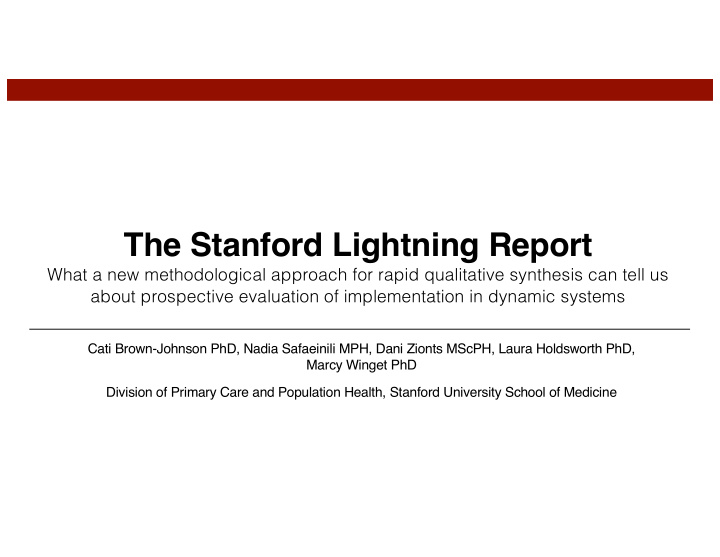



The Stanford Lightning Report What a new methodological approach for rapid qualitative synthesis can tell us about prospective evaluation of implementation in dynamic systems Cati Brown-Johnson PhD, Nadia Safaeinili MPH, Dani Zionts MScPH, Laura Holdsworth PhD, Marcy Winget PhD Division of Primary Care and Population Health, Stanford University School of Medicine
2 Conflicts of Interest None
3 Contents 1. Origin Story - The Lightning Report 2. How to Make a Lightning Report 3. Exploration - CFIR analysis of 14 Lightning Reports 4. Next Steps
4 Contents 1. 1. Or Origin Story - The Lightn tning Report t 2. How to Make a Lightning Report 3. Exploration - CFIR analysis of 13 Lightning Reports 4. Next Steps
5
6 Contents 1. Origin Story - The Lightning Report 2. 2. Ho How w to Mak Make e a a Lig Light htning ning Rep eport 3. Exploration - CFIR analysis of 13 Lightning Reports 4. Next Steps
Lightning Report Method 1. Pre-planning with healthcare evaluation partners 1. Rapid synthesis a) structured research notes b) two researchers discuss notes/memos c) synthesize findings using Plus/Delta/Insight debriefing 2. Lightning Report creation Risks Insights Positives
8
9 Contents 1. Origin Story - The Lightning Report 2. How to Make a Lightning Report 3. 3. Ex Exploration n - CF CFIR analy analysis is of f 13 13 Lig Light htning ning Rep eports 4. Next Steps
CFIR Analysis 10 Objective: to assess which implementation outcomes this rapid synthesis approach (Lightning Report) best captures, and which implementation outcomes are not gathered Coding: Consolidated Framework for Implementation used to code findings from 13 Lightning Reports from 4 projects; 245 excerpts relevant to implementation science Additional barrier/facilitator coding for all excerpts
Most frequent CFIR constructs cluster in Inner setting 11 Readiness for Implementation (n=39) • Availability of resources as facilitators (training): “Health coaching interprofessional training provided” or barriers (space): “lack of penetration [due to] not being co-located” Implementation Climate (n=35) • Compatibility: “Many aspects of the intervention already in place at the new clinic” Patient needs/resources (n=34) • Frequent patient relationship theme, likely due to major interventions revolving around care coordination
Forgotten CFIR domain: Characteristics of Individuals (18 out of 245 excerpts) 12 • Is limited information about individuals attributable to the internal audience? • Single external intervention Lightning Report (where we did not personally know on-the-ground implementing providers and staff) had the most information about characteristics of individuals (n=4)
Facilitators and Barriers Facilitators Barriers 13 Patient needs and resources (17) Patient needs and resources (11) Networks and communication (15) Compatibility (11) Adaptability (9) Networks and communication (10) Available resources* (8) Access to knowledge & info (10) Complexity (10) Themes of staff experience: Themes of role definition: • intervention adaptation by front- • lack of role definition, • inappropriateness tasks for line staff • staff training non-clinical staff, • miscommunication/ misunderstanding of new roles
14 Contents 1. Origin Story - The Lightning Report 2. How to Make a Lightning Report 3. Exploration - CFIR analysis of 14 Lightning Reports 4. 4. Nex Next Step eps
Next steps Using the Lightning Report: • Don’t be afraid to try this at home (you can always also record all your interviews for back-up) • Variations – cumulative reporting vs snapshot • Ideal as partner in PDSA-like interventions Research: • Compare Lightning Report creation across groups/individuals • Compare Lightning Report results to fully coded transcript results
Thank you Lightning Report method to prospectively evaluate dynamic system implementation • Prompt communication with stakeholders (healthcare partners) • Immediate, actionable insights • Methodological rigor - standard methods Questions? Cati Brown-Johnson PhD cbrojohnson@Stanford.edu
Recommend
More recommend